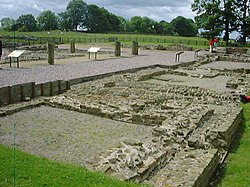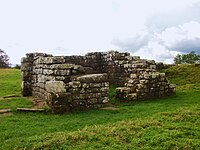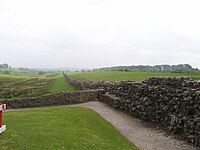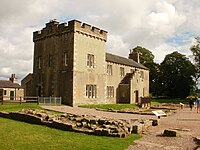Birdoswald
| Birdoswald Latin: Banna | |
|
Cumberland | |
|---|---|

| |
| Type: | Roman fort |
| Location | |
| Grid reference: | NY615663 |
| Location: | 54°59’22"N, 2°36’8"W |
| History | |
| Built c. 112 | |
| Information | |
| Owned by: | English Heritage |
| Website: | Birdoswald Roman Fort, Hadrian's Wall |
Birdoswald Roman Fort, known to the Romans as Banna, was a fort, towards the western end of Hadrian's Wall. The site, in Cumberland, was later occupied by a farm called 'Birdoswald'; it is the only site on Hadrian's Wall at which significant occupation in the post-Roman period has been proven, and it is subject to a long-term archaeological programme.
Birdoswald is one of the best preserved of the sixteen forts along Hadrian's Wall. It is situated in a commanding position on a triangular spur of land bounded by cliffs to the south and east overlooking a broad meander of the River Irthing in Cumberland. The Roman name of the fort, Banna, is the Latin for "spur" or "tongue", reflecting the geography of the site.
Today the fort is in the care of English Heritage.
The fort


The fort was occupied by Roman auxiliaries from approximately AD 112 to AD 400. In this western part of Hadrian's Wall, the wall itself was originally built from turf, later replaced with stone. (Hogan, 2007) The stone fort was built at some time after the wall, in the usual playing card shape, with gates to the east, west and south. Inside were built the usual stone buildings, a central headquarters building (principia), granaries (horrea), and barracks. Unusually for an auxiliary fort, it also included an exercise building (basilica exercitatoria), perhaps reflecting the difficulties of training soldiers in the exposed site in the north of Britannia.
Excavations between 1987 and 1992 showed an unbroken sequence of occupation on the site of the fort granaries, running from the late Roman period until possibly around the year 500. The granaries were replaced by two successive large timber halls, reminiscent of others found in many parts of Britain dating to the 5th and 6th centuries. Tony Wilmott (director of the excavations) has suggested that, after the end of Roman rule in Britain, the fort served as the power-base for a local warband, possibly deriving legitimacy from their Roman predecessors (or even ancestors) for several generations.
Extensive geophysical surveys, both magnetometry and earth resistance survey, were conducted by TimeScape Surveys (Alan Biggins & David Taylor, 1999 & 2004) between 1997 -2001. These surveys established that the sub-surface remains in the fort were well preserved. The later surveys detected two vici (civilian settlements) of different characters on the eastern and western sides of the fort. The surveys by TimeScape also determined the location of a bathhouse in the valley of the River Irthing.
An area between the fort and the escarpment was excavated by Channel 4's archaeological television programme Time Team in January 2000. The excavation detected signs of an extramural settlement (vicus), but the area is liable to erosion and the majority of the vicus could have fallen over the cliffs.
The wall

The two mile sector of Hadrian's Wall either side of Birdoswald is also of major interest. It is currently the only known sector of Hadrian's Wall in which the original turf wall was later replaced by a stone wall on a different line. When the rebuilding took place (probably in the 130s) the line of the wall was moved approximately 50 yards further north, to line up with the fort's north wall, rather than its east and west gates. The reasons for this change are unclear, although David Woolliscroft[1] has plausibly suggested that it was the result of changing signalling requirements. At any rate, this remains the only area in which both the walls can be directly compared.
Approximately 600 metres east of Birdoswald, at the foot of an escarpment, lies the remains of Willowford bridge. This carried Hadrian's Wall across the River Irthing. The westward movement of the river course over the centuries has left the east abutment of the bridge high and dry, while the west abutment has probably been destroyed by erosion. Nevertheless, the much-modified visible remains are highly impressive. Until 1996, these remains were not directly accessible from the fort, but they can now be reached by a footbridge that was lowered into position by an RAF Chinook helicopter.
Maiden Way
- Main article: Maiden Way
The fort at Birdoswald was linked by a Roman road, known as the Maiden Way, to the outpost fort of Bewcastle, seven miles to the north. Signals could be relayed between the two forts by means of two signalling towers.
The fort today

Today the fort's site is operated by English Heritage as Birdoswald Roman Fort. The visitor centre features displays and reconstructions of the fort, exhibits about life in Roman Britain, the site's history through the ages, and archaeological discoveries in the 19th and 20th centuries. Visitors can walk outside along the excavated remains of the fort.
Outside links
| ("Wikimedia Commons" has material about Birdoswald) |
- Birdoswald Roman Fort Hadrian's Wall - English Heritage
- Banna (Birdoswald) on NorthoftheTyne
- Time Team excavation
- Interactive tour
- Youth Hostel
- Review of English Heritage booklet
- iRomans Website showing Birdoswald objects at Tullie House Museum and the forts position on the wall
References
- ↑ Woolliscroft, 2001
- Biggins, J. A. and Taylor, D. J. A., 1999, A Survey of the Roman Fort and Settlement at Birdoswald, Cumbria. Britannia. 30. 91-110.
- Biggins, J. A, and Taylor, D. J. A., 2004, Geophysical Survey of the Vicus at Birdoswald Roman Fort, Cumbria, Britannia 35, 159-178.
- Birdoswald Roman Fort, Tony Wilmott, English Heritage, 2005
- Hogan, C.Michael (2007) Hadrian's Wall, ed. A. Burnham, The Megalithic Portal
- Wilmott T (2001), "Birdoswald Roman Fort", Tempus, ISBN 0-7524-1913-7
- Woolliscroft D.J.(2001), "Hadrian's Wall from the air", Tempus,ISBN 0-7524-1946-3
| Forts on Hadrian's Wall | ||
|---|---|---|
| Wall forts (west to east) |
Maia • Coggabata • Aballava • Uxelodunum • Camboglanna • Birdoswald (Banna) • Magnae • Aesica • Housesteads (Vercovicium) • Carrawburgh (Procolita) • Cilurnum • Onnum • Vindobala • Condercum • Pons Aelius • Segedunum | |
| Stanegate forts |
Luguualium • Brampton Old Church • Castle Hill Boothby • Nether Denton • Throp • Magnis • Haltwhistle Burn • Vindolanda • Newbrough • Corstopitum | |
| Outpost Forts |
Habitancum • Fanum Cocidi • Castra Exploratorum • Blatobulgium | |
| Cumberland coast forts (north to south) |
Bibra • Alauna • Burrow Walls • Gabrosentum | |
